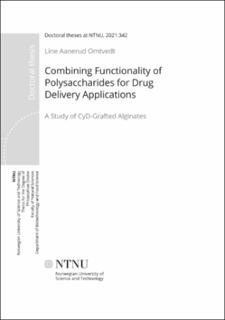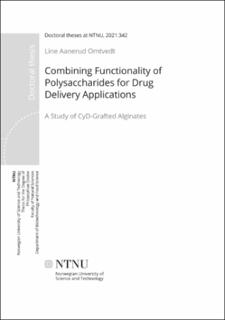| dc.contributor.advisor | Strand, Berit L. | |
| dc.contributor.advisor | Aachmann, Finn L. | |
| dc.contributor.author | Omtvedt, Line Aanerud | |
| dc.date.accessioned | 2021-11-01T08:21:24Z | |
| dc.date.available | 2021-11-01T08:21:24Z | |
| dc.date.issued | 2021-11 | |
| dc.identifier.isbn | 978-82-326-5681-3 | |
| dc.identifier.issn | 2703-8084 | |
| dc.identifier.uri | https://hdl.handle.net/11250/2826722 | |
| dc.description.abstract | The biopolymer alginate has a vast potential for use within biomedical applications largely due to its ability to form ionically crosslinked hydrogels under gentle conditions. Furthermore, the versatile ways the polymer can be tailored give rise to the possibility of altering the alginates for specific needs and functions. In this thesis, the main focus was to explore how the alginate hydrogel could be tailored for use in drug delivery, and how the subsequent modification otherwise alters the properties and behavior of the gel. The hydrophilic environment of the alginate hydrogel can be problematic for delivery of both hydrophilic and hydrophobic drugs. For hydrophilic drugs, the compound may be released too fast, while for hydrophobic drugs both load and release may be difficult due to problems dissolving the compound. Cyclodextrins (CyDs) are cyclic oligosaccharides that are capable of forming inclusion complexes with various hydrophobic molecules and moieties. The CyDs can therefore help dissolve drugs that are otherwise difficult to dissolve in an aqueous environment. On the other hand, if a drug is easily dissolved in water, but has a moiety able to interact with the CyD cavity, this can prolong the release of drugs that would otherwise give a too fast release profile.
To combine the hydrogel forming properties of the alginate with the ability of the CyDs to form inclusion complexes with various drugs, β CyDs were grafted to alginate. This was done using a three-step procedure where alginates first are oxidized followed by linker attachment using reductive amination and finally attachment of CyD to the linker via Cu(I)-catalyzed click chemistry. M- and MG-blocks were also terminally functionalized with both β and γ-CyDs by using first hydrazide and then click chemistry. In contrast, the reducing end of G-blocks were not successfully attached with CyDs, likely due to the G-blocks affinity towards the catalyst used in the click-chemistry reaction. In addition to this, alginate was also functionalized with either the RGD-peptide GRGDSP commonly used for cell attachment, or L-Tyrosine methyl ester (MeOTyr) used as a model small-size substitute.
As the properties of the alginate hydrogel is closely linked to the structure of the biopolymer, the mechanical properties and stability of CyD functionalized Ca alginate hydrogels were examined. Alginate modified with other molecules, such as peptides with cell-binding motifs were also studied. Generally, the modified hydrogels formed less stable and weaker gels than their unmodified counterparts. However, this could be controlled to a certain degree by creating hydrogels from mixtures of both functionalized and non modified alginate, as well as controlling the degree of oxidation for the grafted alginates. A strategy using chemoenzymatic modification was also compared to using purely chemical modifications. This showed a potential to slightly increase the mechanical properties of the modified gels as seen for stress needed to rupture the gels. However, non-modified Ca-alginate hydrogels still showed markedly higher stiffness and stability in the form of resistance to breakage and dissolution. Leakage studies of the grafted Ca-hydrogels in saline treatment solutions showed that grafted material leaked out of the hydrogels.
Finally, the CyD-grafted alginate was tested as a drug delivery system for a partially water-soluble molecule, methyl orange, and the hydrophobic anti-cancer drug, paclitaxel. Grafted alginate gel-beads were able to take up and release more methyl orange compared to non grafted beads. For paclitaxel, the grafted material helped dissolve the hydrophobic drug in the aqueous hydrogel environment and facilitated release. The released paclitaxel and degradation products were shown to have a cytotoxic effect on prostate cancer cells. To conclude, the CyD grafted alginate can aid alginate hydrogels in delivering both partially hydrophilic molecules with hydrophobic moieties and hydrophobic drugs. | en_US |
| dc.language.iso | eng | en_US |
| dc.publisher | NTNU | en_US |
| dc.relation.ispartofseries | Doctoral theses at NTNU;2021:342 | |
| dc.relation.haspart | Paper 1:
Omtvedt, Line Aanerud; Dalheim, Marianne Øksnes; Nielsen, Thorbjørn T.; Larsen, Kim; Strand, Berit Løkensgard; Aachmann, Finn Lillelund.
Efficient Grafting of Cyclodextrin to Alginate and Performance of the Hydrogel for Release of Model Drug. Scientific Reports 2019 ;Volum 9.(1) s. 1-11 https://doi.org/10.1038/s41598-019-45761-4 This article is licensed under a Creative Commons Attribution 4.0 International License (CC BY 4.0) | |
| dc.relation.haspart | Paper 2:
Dalheim, Marianne Øksnes; Omtvedt, Line Aanerud; Bjørge, Isabel M.; Akbarzadeh, Anita; Mano, Joao F.; Aachmann, Finn Lillelund; Strand, Berit Løkensgard.
Mechanical Properties of Ca-Saturated Hydrogels with Functionalized Alginate. Gels 2019 ;Volum 5.(2) Suppl. 23 s. 1-19
https://doi.org/10.3390/gels5020023
This is an open access article distributed under the Creative Commons Attribution License (CC BY 4.0) | |
| dc.relation.haspart | Paper 3:
Omtvedt, Line Aanerud; Kristiansen, Kåre Andre; Strand, Wenche Iren; Aachmann, Finn Lillelund; Strand, Berit Løkensgard; Zaytseva-Zotova, Daria.
Alginate hydrogels functionalized with β-cyclodextrin as a local paclitaxel delivery system. Journal of Biomedical Materials Research. Part A 2021 ;Volum 109.(12) s. 2625-2639
https://doi.org/10.1002/jbm.a.37255
This is an open access article under the terms of the Creative Commons Attribution License (CC BY 4.0) | |
| dc.relation.haspart | Paper 4:
Omtvedt, Line Aanerud; Solberg, Amalie; Mo, Ingrid V; Christensen, Bjørn E; Strand, Berit L.; Aachmann, Finn L.
Alginate Oligomers Terminally Functionalized with β- and
γ-Cyclodextrins. | |
| dc.subject | Alginate | en_US |
| dc.subject | Cyclodextrin | en_US |
| dc.subject | Drug delivery | en_US |
| dc.subject | Chemical modification | en_US |
| dc.subject | Partially oxidized alginate | en_US |
| dc.subject | Cu-catalyzed click chemistry | en_US |
| dc.subject | Hydrogels | en_US |
| dc.title | Combining Functionality of Polysaccharides for Drug Delivery Applications - A Study of CyD-Grafted Alginates | en_US |
| dc.type | Doctoral thesis | en_US |
| dc.subject.nsi | VDP::Technology: 500::Food science and technology: 600 | en_US |

